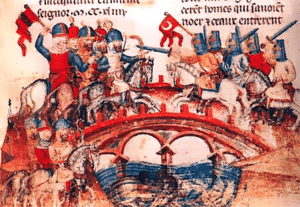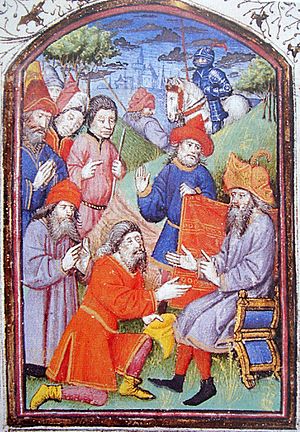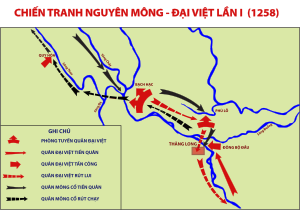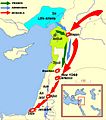Möngke Khan facts for kids
Quick facts for kids
|
|||||||||||||
|---|---|---|---|---|---|---|---|---|---|---|---|---|---|
| 4th Khagan-Emperor of the Mongol Empire (Supreme Khan of the Mongols) Emperor of the Yuan dynasty (posthumously) |
|||||||||||||
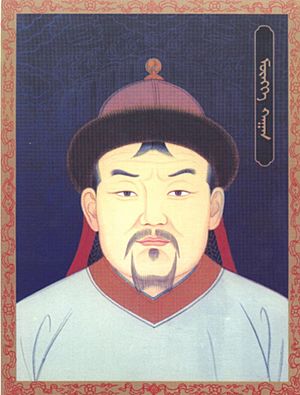 |
|||||||||||||
| 4th Khagan-Emperor of the Mongol Empire | |||||||||||||
| Reign | 1 July 1251 – 11 August 1259 | ||||||||||||
| Coronation | 1 July 1251 | ||||||||||||
| Predecessor | Güyük Khan | ||||||||||||
| Successor | Ariq Böke | ||||||||||||
| Born | 11 January 1209 Mongol Empire |
||||||||||||
| Died | 11 August 1259 (aged 50) modern-day Diaoyu Fortress, Chongqing, Southern Song dynasty, China |
||||||||||||
| Burial | Burkhan Khaldun, Khentii Province | ||||||||||||
|
|||||||||||||
| House | Borjigin | ||||||||||||
| Father | Tolui | ||||||||||||
| Mother | Sorghaghtani Beki | ||||||||||||
| Religion | Tengrism | ||||||||||||
Möngke (Mongolian: ᠮᠥᠩᠬᠡ Möngke / Мөнх Mönkh; Chinese: 蒙哥; pinyin: Ménggē; 11 January 1209 – 11 August 1259) was the fourth Great Khan of the Mongol Empire. He ruled from July 1, 1251, to August 11, 1259. Möngke was the first Great Khan from the Tolui family line. He made many important changes to improve how the vast Mongol Empire was run. Under his rule, the Mongols conquered new lands like Iraq, Syria, and the kingdom of Dali (which is now Yunnan in China).
Möngke Khan: A Powerful Mongol Leader
Early Life and Rise to Power
Möngke was born on January 11, 1209. He was the oldest son of Genghis Khan's son, Tolui, and his wife, Sorghaghtani Beki. A spiritual leader named Teb Tengri Khokhcuu believed Möngke would have a great future. He gave him the name Möngke, which means "eternal" in Mongolian. Möngke was raised by his uncle Ögedei Khan's queen, Angqui, at her nomadic palace. Ögedei also made sure Möngke learned to write from a Persian scholar.
In 1224, when Möngke was fifteen, he went on his first hunt with his brother, Kublai Khan. Their grandfather, Genghis Khan, performed a special Mongol tradition. He smeared fat from the animals they hunted onto their middle fingers.
Möngke first went to war in 1230 with his father and uncle Ögedei against the Jin dynasty. After his father Tolui died in 1232, Möngke's mother, Sorghaghtani, became the head of their family's lands. Möngke also inherited one of his father's wives, Oghul-Khoimish. He cared for her deeply and favored her daughter, Shirin.
In 1235, Möngke was sent to fight in the west against the Kipchaks, Russians, and Bulgars. He showed great bravery, even capturing a powerful Kipchak chief. Möngke also fought in the Mongol invasion of Rus' and the Siege of Kiev (1240). He joined Batu Khan at the Battle of Mohi. In 1241, Möngke returned home after his uncle Ögedei called him back. Ögedei died shortly after.
After Ögedei's death, there was a struggle for power. Möngke and Batu Khan became the main contenders for the throne.
Becoming the Great Khan
Möngke followed his mother's advice and met with Batu Khan. Batu decided to support Möngke's claim to be the next Great Khan. They called a special meeting, called a kurultai, to choose the new leader. Many important Mongol leaders came to this meeting.
On July 1, 1251, a second kurultai was held. Möngke was officially declared the Great Khan of the Mongol Empire. Some princes from other Mongol family lines also agreed with this decision.
Soon after, some of Möngke's relatives tried to overthrow him. Möngke's falconer discovered their plan. After an investigation, Möngke decided to punish those who were guilty. Many aristocrats and commanders were punished or exiled. Möngke's mother, Sorghaghtani, helped accuse Oghul Qaimish of using black magic. Oghul Qaimish was drowned, which was the Mongol punishment for that crime.
After becoming Great Khan, Möngke announced that he would follow the ways of his ancestors. He also honored his father by giving him the title of Ikh Khagan. Möngke shared control of the western part of the empire with his ally, Batu Khan. This helped keep the empire united. Möngke's mother, Sorghaghtani, died in 1252.
Möngke gave his brothers, Kublai Khan and Hulagu Khan, important roles. Kublai was put in charge of North China, and Hulagu was sent to Iran. Later, Möngke sent inspectors to check on Kublai's work in China. They found problems, but Möngke forgave his brother after Kublai apologized.
Möngke's Rules and Reforms
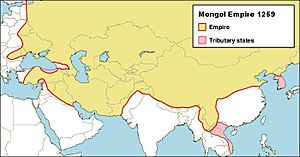
Möngke was very involved in creating new rules and making sure they were followed. He stopped nobles from spending too much money. He also changed gifts to princes into regular salaries. Merchants now had to pay taxes. Möngke tried to stop unfair practices and sent officials to watch over merchants. He also stopped people from misusing the imperial relay stations, called yam, and special tablets, called paizas, which gave power to demand services.
Möngke made sure that all debts from the previous Great Khan were paid. This made merchants trust the Mongols more. He also punished generals and princes who allowed their soldiers to steal from civilians. Möngke used officials from different backgrounds, including Chinese, Muslim, and Uyghur people.
In 1253, Möngke created a special department to control the printing of paper money. This helped stop too much money from being printed. He also set up a standard measure based on silver. However, foreign lands under Mongol rule could still use their own coins and weights.
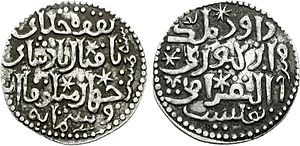
Between 1252 and 1259, Möngke ordered a census (a count of people and resources) across the entire Mongol Empire. This included lands like Iran, Afghanistan, Georgia, Armenia, Russia, Central Asia, and North China. The census counted households, men aged 15–60, fields, livestock, and orchards. It helped the Mongols collect taxes more fairly. However, some people still protested the taxes.
In 1259, the Georgian king, David VI, rebelled against the Mongols but failed. Möngke's officials punished Georgian and Armenian nobles harshly. They also put down a rebellion in Kashmir.
Religious Tolerance and Diplomacy
Möngke was generally tolerant of different religions. He confirmed Haiyun as the chief of all Buddhists in the empire. He also made Namo from Kashmir the chief of all Buddhist monks. Buddhist clergy were not taxed. Möngke also supported the Tibetan Buddhist leader Karma Pakshi.
Möngke had been impressed by a Taoist monk who met his grandfather, Genghis Khan. Möngke made Li Zhichang the chief of the Taoists. However, Taoists were taking over Buddhist temples. Möngke ordered them to stop criticizing Buddhism. He asked his brother Kublai to settle arguments between Taoists and Buddhists. In 1258, Kublai held a meeting where the Taoist claims were proven wrong. Many Taoist temples were then converted to Buddhist ones.
Möngke also showed favor to Muslims. He made the Twelver Muslim community in Najaf a special area free from taxes. Like earlier Mongol rulers, he did not tax religious leaders, churches, mosques, monasteries, or doctors.
During Möngke's reign, Louis IX of France sent a diplomat named William of Rubruck to seek an alliance with the Mongols against the Muslims. Möngke met with Rubruck in 1254. Rubruck told him he came to spread the word of Jesus. Rubruck stayed to help Christians in Karakorum and attended religious debates organized by the Mongols.
King Hethum I of Lesser Armenia also visited Möngke in 1254. He brought gifts and met with Möngke. Hethum asked Möngke to convert to Christianity. Möngke explained that he wanted his people to truly worship, but he would not force them to change their religion. Möngke also told Hethum he planned to attack Baghdad and would give Jerusalem to Christians if they helped him. Hethum encouraged other Crusaders to work with the Mongols.
Expanding the Empire
Möngke took the idea of world conquest very seriously. His main goals were to conquer more lands in East Asia and the Middle East. In 1252, he decided to conquer Korea and the Dali Kingdom in Yunnan.
Conquering Korea
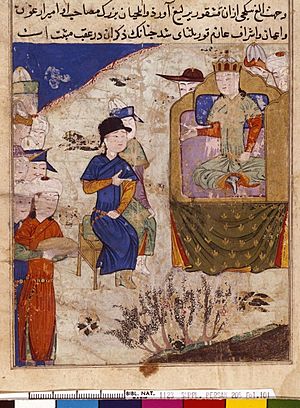
Möngke sent messengers to Goryeo (Korea) in 1251 to announce his coronation. He demanded that King Gojong of Goryeo come to meet him and move his capital from Ganghwa Island back to the mainland. The Korean court refused, saying the king was too old to travel.
Möngke then sent his army, led by Prince Yeku, to Korea in 1253. The Korean court refused to surrender but did not fight the Mongols directly. Instead, they moved their people to mountain forts and islands. The Mongols, with help from some Koreans, devastated the land. King Gojong eventually sent his stepson as a hostage to Mongolia, and the Mongols agreed to a ceasefire in 1254.
Möngke realized the hostage was not the king's true son and felt tricked. His commander, Jalairtai, continued to devastate Korea, taking many captives. Famine forced many peasants to surrender. The Mongols even made Korean defectors build ships to attack coastal islands.
In 1258, the Korean king and his officials assassinated the head of the Choe family, who had been resisting the Mongols. They then asked for peace. When the future king of Goryeo was sent as a hostage, the Mongols finally left Korea.
Adventures in Southeast Asia
Möngke also focused on conquering the Song dynasty in China. He planned to attack them from different directions. To do this, he first conquered the Kingdom of Dali in 1254 and invaded Indochina.
Möngke sent his brother Kublai Khan to the Dali Kingdom in 1253. The ruling family resisted and killed the Mongol messengers. The Mongols attacked from three sides. Kublai captured the capital city of Dali and spared its people, even though his messengers had been killed. The Mongols appointed the local king, Duan Xingzhi, to rule under them. By 1256, the Dali Kingdom was fully under Mongol control.
After conquering Dali, Kublai sent an army south into Vietnam (then called Đại Việt). The Vietnamese imprisoned the Mongol messengers. In 1257, a Mongol army invaded Vietnam. They defeated the Vietnamese army and captured the capital, Thăng Long (now Hanoi). The Mongols executed some people for killing their messengers. The Mongols soon became sick from the unfamiliar climate. The Vietnamese launched a counter-attack and won a key battle. To avoid more war, the Vietnamese king accepted Mongol rule and sent tributes to Möngke.
To control Tibet, Möngke appointed a commander for Mongol and Chinese troops there in 1251. In 1252–1253, the Mongols invaded Tibet, and many monasteries submitted to them.
Battles in the Middle East
When Möngke planned his next conquests in 1252, the Sultanate of Rum and the Lu'lu'id dynasty of Mosul were already under Mongol rule. Other rulers in the Middle East also sent envoys to Möngke.
Möngke decided to attack the Nizari Ismailis (also known as Assassins). In 1252, he gave this mission to his brother Hulagu Khan. Hulagu's main goals were to conquer the Nizari state and the Abbasid Caliphate. Möngke sent 1,000 siege engineers from China to help Hulagu's army. By the end of 1256, Hulagu had crushed the last major resistance of the Ismailis in Iran.
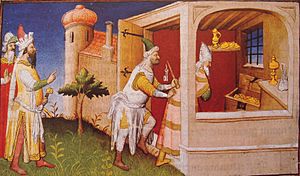
For the Abbasids, messengers from Baghdad met Möngke in 1251. However, Möngke told Hulagu that if the Caliph Al-Musta'sim refused to meet him, Hulagu should destroy Baghdad. Hulagu then attacked Iraq and captured Baghdad in 1258. Möngke sent a Chinese messenger to congratulate Hulagu on his victory.
Outraged by the attack on the Caliphate, a local ruler named Malik Kamil rebelled. Hulagu's son captured and executed Malik Kamil. From there, the Mongols moved into Syria in 1259, taking Damascus and Aleppo. They reached the shores of the Mediterranean Sea.
Campaigns in China
Möngke focused all his attention on conquering the Song dynasty in South China. He personally led campaigns and captured many fortified cities.
In 1252, Möngke sent his younger brother Kublai Khan and general Uriyangkhadai to conquer the Dali Kingdom. These campaigns were successful. After Kublai returned to North China, Uriyangkhadai conquered other tribes before moving east towards Vietnam.
In October 1257, Möngke set out for South China. He left his brother, Ariq Böke, in charge of the administration in Karakorum. Möngke attacked Song positions in Sichuan and took Paoning in 1258. He forbade his army from stealing from civilians. He even punished his own son for accidentally destroying a farmer's crops.
In 1259, Möngke was celebrating the Mongol New Year. A relative advised him that South China's climate was dangerous and he should go north for safety. But another leader called this advice cowardly and urged Möngke to stay with his army. Möngke liked this advice and wanted to take a nearby city. The Song commander of that city killed Möngke's messenger who had asked for surrender.
In 1259, Uriyangkhadai's forces attacked Guangxi from Vietnam. This was part of a large, coordinated Mongol attack on the Song dynasty from different directions.
Möngke's Family
Möngke had several wives and children. His main wives included Qutuqtai Khatun, Yesü'er Khatun, Oghul Tutmish, and Chübei Khatun. He also had concubines.
His children included:
- Baltu
- Ürüng-Tash
- Princess Bayalun
- Shiregi
- Princess Shirin
- Princess Bichige
- Asutai
The End of His Reign
Historians are not completely sure how Möngke Khan died. It is known that his last battle was at Diaoyu Fortress in modern-day Chongqing, China. Most agree that he died there, which forced the Mongol armies to retreat.
Chinese sources say Möngke was killed in battle by a crossbow arrow during the siege. A Syrian monk also wrote about this. However, the official History of Yuan, written later, says he died from a wound caused by a stone fired from a cannon or a large slingshot. Mongol history often doesn't clearly describe the deaths of their khans. It is possible they said he died of illness to cover up his death in battle.
Persian accounts say Möngke died of dysentery or cholera near the siege site on August 11, 1259. The Chinese source also mentions a deadly disease outbreak in the Mongol camp.
A month after Möngke's death, his youngest wife, Chubei, also died. Möngke's son Asutai took his body to Burkhan Khaldun in Mongolia. Möngke was buried near the graves of Genghis Khan and Tolui.
Möngke's death in 1259 led to a four-year civil war between his two younger brothers, Kublai Khan and Ariq Böke. Kublai Khan eventually won, but this war and later conflicts permanently divided the Mongol Empire. It was not until 1304 that all Mongol khans again recognized one main ruler.
When Kublai Khan started the Yuan dynasty in China in 1271, Möngke Khan was given the official name Xianzong.
Images for kids
See also
 In Spanish: Möngke para niños
In Spanish: Möngke para niños


